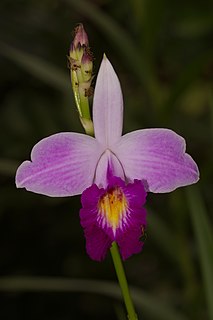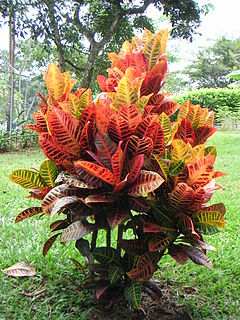
Arundina graminifolia is a species of orchid and the sole accepted species of the genus Arundina. This tropical Asiatic genus extends from Myanmar, India, Sri Lanka, Nepal, Thailand, Vietnam, the Ryukyu Islands, Malaysia, Singapore, China to Indonesia, the Philippines and New Guinea. It has become naturalized in Réunion, Fiji, French Polynesia, Micronesia, the West Indies, Costa Rica, Panama and Hawaii. It is also called bamboo orchid.
Gaoligongshania megalothyrsa is a species of small, bushy mountain bamboo, in the monotypic genus Gaoligongshania. Like Ferrocalamus, this genus is found only in Yunnan Province of China, and near the Myanmar border, at an altitude of 1,600 to 2,200 m. It is named after the Gaoligong Mountains, where it is endemic.

Codiaeum variegatum is a species of plant in the genus Codiaeum, which is a member of the family Euphorbiaceae. It was described by Carl Linnaeus in 1753. It is native to Indonesia, Malaysia, Australia, and the western Pacific Ocean islands, growing in open forests and scrub.

Bambusa vulgaris, common bamboo, is an open-clump type bamboo species. It is native to Indochina and to the province of Yunnan in southern China, but it has been widely cultivated in many other places and has become naturalized in several regions. Among bamboo species, it is one of the largest and most easily recognized.

Ipomoea indica is a species of flowering plant in the family Convolvulaceae, known by several common names, including blue morning glory, oceanblue morning glory, koali awa, and blue dawn flower. It bears heart-shaped or 3-lobed leaves and purple or blue funnel-shaped flowers 6–8 cm (2–3 in) in diameter, from spring to autumn. The flowers produced by the plant are hermaphroditic. This plant has gained the Royal Horticultural Society's Award of Garden Merit.
Arundinaria appalachiana, commonly known as hill cane, is a woody bamboo native to the Appalachian Mountains in the southeastern United States. The plant was elevated to the species level in 2006 based on new morphological and genetic information and was previously treated as a variety of Arundinaria tecta. As a relatively small member of its genus, it usually only attains heights of 0.5 to 1.0 metre with an either dense or diffuse habit. It is one of only three temperate species of bamboo native to North America. Hill cane is common on dry to mesic sites on upland slopes, bluffs and ridges in oak-hickory forests. In contrast to its sympatric relatives, Arundinaria gigantea typically appears along perennial streams, while A. tecta is found in swamps and other very wet areas.

Pentadiplandra brazzeana is an evergreen shrub or liana that is the only species assigned to the genus Pentadiplandra, and has been placed in a family of its own called Pentadiplandraceae. It produces large red berries, sometimes mottled with grey. It is known from West-Central Tropical Africa, between northern Angola, eastern Nigeria and western Democratic Republic of Congo. The berry is sweet in taste due to the protein, brazzein, which is substantially sweeter than saccharose. Brazzein may be useful as a low-calorie sweetener, but is not yet allowed as a food additive in the United States and the European Union.

Yushania alpina, the African alpine bamboo, is a perennial bamboo of the family Poaceae and the genus Yushania It can be found growing in dense but not large stands on the mountains and volcanoes surrounding the East African Rift between the altitudes of 2,500 meters and 3,300 meters.
Psilolemma is a genus of plants in the grass family. The only known species is Psilolemma jaegeri, native to the Democratic Republic of the Congo, Kenya, Uganda and Tanzania.

Bambusa bambos, the giant thorny bamboo, Indian thorny bamboo, spiny bamboo, or thorny bamboo, is a species of clumping bamboo native to southern Asia. It is also naturalized in Seychelles, Central America, West Indies, Java, Malaysia, Maluku, and the Philippines.

Roscoea kunmingensis is a perennial herbaceous plant native to the mountains of China, being found in Yunnan. Most members of the ginger family (Zingiberaceae), to which it belongs, are tropical, but R. kunmingensis, like other species of Roscoea, grows in much colder mountainous regions.
Acanthopale pubescens is a species of the genus Acanthopale of the family Acanthaceae. The species occurs in East and Southern Africa. Acanthopale pubescensis also known as Herayye in Ethiopia.
Adenorandia is a monotypic genus of flowering plants in the family Rubiaceae. It was described by Vermoesen in 1922. The genus contains only one species, viz. Adenorandia kalbreyeri, which is found from west-central tropical Africa.

Hymenodictyon parvifolium Oliv. is a small rubiaceous African tree and is one of some 24 species in the genus, with a tropical African and Asian distribution. This species grows as a small tree to some 5 metres tall, or sometimes a liane or scrambler to 10.5 m, and is found in low-altitude woodland.
Dendrocalamus longispathus, the long-sheath bamboo, is a bamboo species which grows up to 20 m tall. It is native to Bangladesh, Myanmar, and Thailand. It has now become an exotic species all over the South Asia.

Brexia is a plant genus assigned to the Celastraceae. It is a dense evergreen shrub or small tree of usually around 5 m high, with alternately set, simple, leathery leaves with a short leaf stem and lanceolate to inverted egg-shaped leaf blades. The pentamerous flowers occur in cymes. The petals are greenish white, the samens are alternating with wide, incised staminodes. The superior ovary develops in a long ribbed fruit. Brexia naturally grows on the coast of East Africa, on Madagascar, the Comoros and Seychelles. Opinions differ about the number of species in Brexia. Sometimes the genus is regarded monotypic, B. madagascariensis being a species with a large variability, but other authors distinguish as many as twelve species. Common names for B. madagascariensis include jobiapototra, tsimiranjana, tsivavena, vahilava, voalava, voankatanana, voantalanina, voatalanina and votalanina, and mfukufuku (Swahili), mfurugudu and bwa kato (Seychelles).

Marantochloa purpurea is a species of plant in the family Marantaceae. It is found in tropical Africa, where its natural habitat is moist lowland forest. The leaf stems are used for various purposes including making string, baskets, mats and traps and the leaves are used for thatching, and for wrapping objects.

Hewittia malabarica is a flowering plant in the monotypic genus HewittiaWight & Arn., belonging to the family Convolvulaceae and widespread throughout tropical Africa, Asia, and Polynesia. It is a climbing or prostrate perennial herb with slender stems and flowers that are pale yellow, cream, or white with a purple center, and large leaves that can be used as a cooked vegetable or used in folk medicine with the roots. The stems can be used to make ropes.
Hoffmannanthus is a monotypic genus of flowering plants in the Asteraceae. There is only one known species, Hoffmannanthus abbotianus(O.Hoffm.) H.Rob., S.C.Keeley & Skvarla It's native range is Uganda and southern Tropical Africa. It is found in the countries of Angola, Kenya, Tanzania, Uganda, Zambia and Zaïre.
Jeffreycia is a genus of African flowering plants in the daisy family. They are in the Vernonieae subtribe.
















